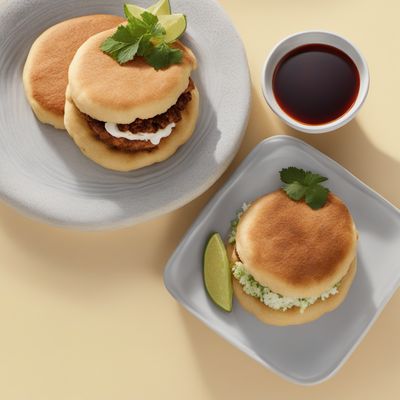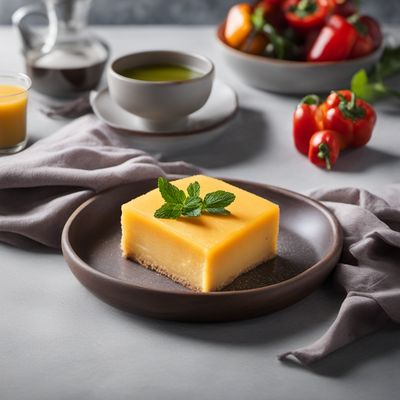
Ingredient
Cheese, tetilla
The Creamy Wonder of Tetilla Cheese
Tetilla cheese is a semi-soft cow's milk cheese with a pale yellow color and a distinctive cone shape. Its creamy texture is complemented by a mild, buttery flavor that lingers on the palate. This versatile cheese can be enjoyed on its own or used in both sweet and savory recipes.
Origins and history
Tetilla cheese originates from the Galicia region in northwestern Spain. It has a long history dating back to the 16th century when it was first produced by local farmers. The cheese's name, tetilla
Nutritional information
Tetilla cheese offers a delicate and buttery flavor profile with subtle hints of sweetness. Its smooth and creamy texture melts beautifully when heated, making it ideal for melting over dishes or incorporating into sauces. The cheese's mild taste allows it to pair well with a variety of ingredients, enhancing the overall flavor of any dish.
Allergens
Tetilla cheese is a good source of calcium, protein, and essential vitamins. It is relatively low in fat compared to other cheeses, making it a healthier option for cheese lovers. However, it is still important to consume it in moderation due to its calorie content.
How to select
Tetilla cheese is made from cow's milk and does not contain any known allergens. However, individuals with lactose intolerance or dairy allergies should exercise caution and opt for lactose-free or dairy-free alternatives.
Storage recommendations
Tetilla cheese is typically produced by artisanal cheesemakers using traditional methods. However, it can be challenging to produce at home due to the specific techniques and aging requirements. It is best to purchase Tetilla cheese from reputable producers or specialty cheese shops.
How to produce
When selecting Tetilla cheese, look for a cheese that is firm yet slightly yielding to the touch. It should have a pale yellow color and a smooth, unblemished rind. Avoid cheeses with any signs of mold or strong odors.
Preparation tips
To maintain the freshness and quality of Tetilla cheese, store it in the refrigerator at a temperature between 35°F and 40°F (1.7°C and 4.4°C). Keep it wrapped in wax paper or parchment paper to allow it to breathe and prevent moisture buildup. Consume within a week of opening for the best flavor and texture.
Substitutions
Tetilla cheese can be enjoyed on its own as part of a cheese platter or paired with fruits, nuts, or honey for a delightful appetizer. It is also commonly used in traditional Spanish dishes like empanadas, croquettes, or Galician-style octopus. Additionally, it can be melted over grilled vegetables, sandwiches, or incorporated into creamy pasta sauces.
Availability
Tetilla cheese is primarily available in Spain, particularly in the Galicia region where it is produced. It can also be found in specialty cheese shops or gourmet markets in other countries.
More ingredients from this category » Browse all

Cheese, marechal
The Bold and Robust Marechal Cheese

Cheese, mimolette
Mimolette: The Bold and Nutty Delight

Cheese, jarlsberg
The Norwegian Delight

Cheese, prastost
The Alpine Delicacy

Cheese, tete de moine
The Art of Swiss Cheese

Cheese, baita friuli
Baita Friuli: A Savory Delight from the Italian Alps

Cheese, asiago
"Aged Delight: Unveiling the Richness of Asiago Cheese"

Cheese, derby
The Delightful Delicacy: Derby Cheese

Cheese, chimay
The Belgian Delight: Chimay Cheese

Cheese, arzua ulloa
The Creamy Delight

Cheese, danbo
The Danish Delight: Exploring the Savory World of Danbo Cheese

Cheese, cheshire
The Quintessential British Cheese: Exploring the Delights of Cheshire Cheese
Recipes using Cheese, tetilla

Caldo de Queso with Roasted Poblano Peppers
Creamy Cheese Soup with a Smoky Twist

Authentic Mexican Cemita Recipe
Heavenly Cemita: A Flavorful Mexican Delight

Galician Cheese Croquettes
Savory Galician Delight: Irresistible Cheese Croquettes

Mexican-American Bublik
Spicy Mexican Bublik Delight

Galician-style Takaku Bread
Santiago de Compostela Bread: A Galician Twist on Takaku Bread

Queso Fundido Fiesta
Tequila-Infused Cheese Fiesta

Nicanores de Boñar
Savory Spanish Cheese Fritters

Pizza Margherita with a Latin American Twist
Salsa-infused Pizza Margherita: A Latin American Delight

Colombian Arepas Paisas
Savory Corn Cakes: A Taste of Colombia's Arepas Paisas

Tarta de Mondoñedo
Savory Spanish Cheese and Vegetable Tart